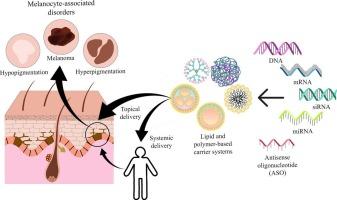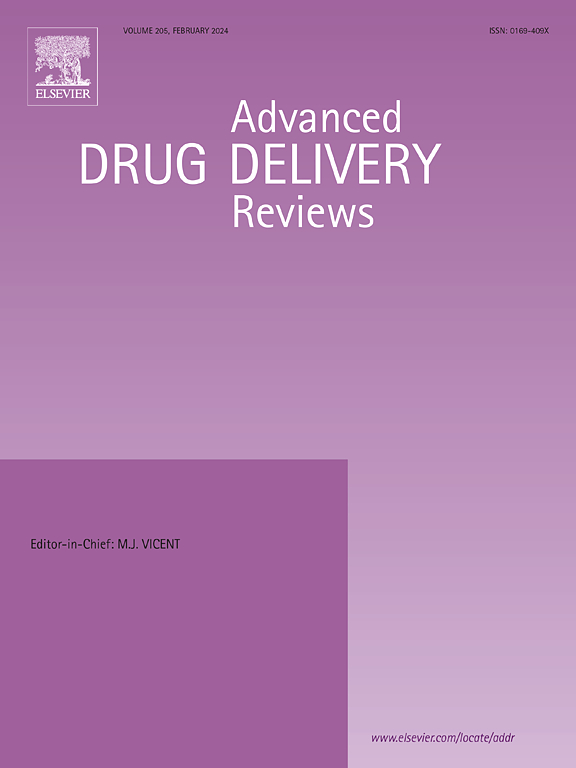Recent advances in gene delivery for melanocyte-associated disorders
IF 17.6
1区 医学
Q1 PHARMACOLOGY & PHARMACY
引用次数: 0
Abstract
Melanocytes are cells present at the epidermal-dermal junction of the skin that produce pigment melanin, which provides color to the skin, eyes, and hair. Dysregulation in melanocyte function, viability, or differentiation can result in melanocyte-associated disorders that can be broadly classified based on etiology as melanocyte hyperproliferation and hyperactivation, defects in melanin synthesis, inflammatory alterations in melanin production/trafficking, melanocyte destruction, and defects in melanocyte migration. While most of these disorders are of benign origin, the cosmetic implications of these conditions are associated with significant psychosocial burden and cultural stigma, having a significant impact on affected individuals. These conditions are primarily driven by changes in underlying gene expression (both at the genetic and epigenetic levels). Targeting the underlying genetic and transcriptomic changes in melanocyte-associated disorders using gene replacement (plasmid DNA, mRNA), gene knockdown (siRNA), or miRNA replacement (miRNA) presents a promising strategy for developing treatments for these conditions. The delivery of naked nucleic acid molecules is challenging, and lipid- and polymer-based particles have been widely evaluated for the successful delivery of biologically active nucleic acids to the melanocytes. This review provides an overview of melanocyte-associated pigmentary disorders and their underlying genetic factors and examines current preclinical and clinical efforts using non-viral polymeric and lipid-based delivery systems for plasmid DNA and RNA-based therapeutics.

黑色素细胞相关疾病基因传递的最新进展
黑色素细胞是存在于皮肤表皮和真皮交界处的细胞,产生黑色素,黑色素为皮肤、眼睛和头发提供颜色。黑素细胞功能、活力或分化的失调可导致黑素细胞相关疾病,这些疾病可根据病因大致分类为黑素细胞过度增殖和过度活化、黑色素合成缺陷、黑色素生产/运输的炎症改变、黑素细胞破坏和黑素细胞迁移缺陷。虽然这些疾病大多是良性的,但这些疾病对美容的影响与严重的社会心理负担和文化耻辱有关,对受影响的个人产生重大影响。这些情况主要是由潜在基因表达的变化驱动的(在遗传和表观遗传水平上)。利用基因替代(质粒DNA, mRNA)、基因敲低(siRNA)或miRNA替代(miRNA)靶向黑素细胞相关疾病的潜在遗传和转录组学变化,为这些疾病的治疗提供了一种有希望的策略。裸核酸分子的递送具有挑战性,脂质和聚合物基颗粒已被广泛评估为成功将生物活性核酸递送到黑素细胞。本文综述了黑素细胞相关的色素紊乱及其潜在的遗传因素,并检查了目前使用非病毒聚合物和脂质递送系统进行质粒DNA和rna治疗的临床前和临床研究。
本文章由计算机程序翻译,如有差异,请以英文原文为准。
求助全文
约1分钟内获得全文
求助全文
来源期刊
CiteScore
28.10
自引率
5.00%
发文量
294
审稿时长
15.1 weeks
期刊介绍:
The aim of the Journal is to provide a forum for the critical analysis of advanced drug and gene delivery systems and their applications in human and veterinary medicine. The Journal has a broad scope, covering the key issues for effective drug and gene delivery, from administration to site-specific delivery.
In general, the Journal publishes review articles in a Theme Issue format. Each Theme Issue provides a comprehensive and critical examination of current and emerging research on the design and development of advanced drug and gene delivery systems and their application to experimental and clinical therapeutics. The goal is to illustrate the pivotal role of a multidisciplinary approach to modern drug delivery, encompassing the application of sound biological and physicochemical principles to the engineering of drug delivery systems to meet the therapeutic need at hand. Importantly the Editorial Team of ADDR asks that the authors effectively window the extensive volume of literature, pick the important contributions and explain their importance, produce a forward looking identification of the challenges facing the field and produce a Conclusions section with expert recommendations to address the issues.

 求助内容:
求助内容: 应助结果提醒方式:
应助结果提醒方式:


